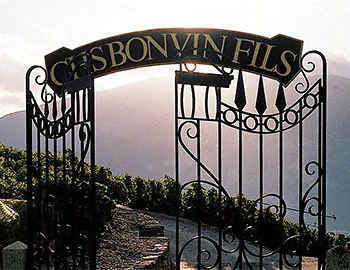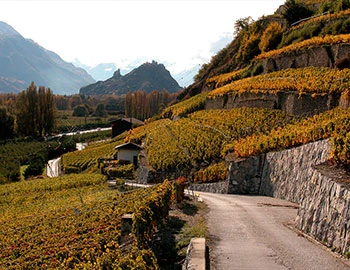Heida 2023
AOC Wallis, Bonvin, 750 ml

| Grape variety: | Heida |
| Producer: | Bonvin |
| Origin: | Switzerland / Wallis |
Description
Heida is a mutation of the Traminer or Gewürztraminer, and it shows in this wine in an impressive way. Its plump body and delicate sweetness are perfectly compensated by a juicy acidity. Orange blossom, pineapple and ripe mango, marzipan, white pepper and anise create a high intensity flavour palette. The finish is aromatic and long with a pleasant mineral tartness.
Attributes
| Origin: | Switzerland / Wallis |
| Grape variety: | Heida |
| Label: | Vegan |
| Ripening potential: | 1 to 6 years |
| Drinking temperature: | 10 to 12 °C |
| Food Pairing: | Moules à la marinière, Risotto with ceps, Cheese board |
| Vinification: | pressed carefully and immediately, fermentation in steel tank, fermentation at low temperatures |
| Harvest: | hand-picking, strict selection |
| Maturation: | in steel tank |
| Volume: | 13.5 % |
| Note: | Contains sulphites |
Bonvin
High above Sion, on the Clos du Château, is the heart of the oldest wine trading house in Valais – today's winery Charles Bonvin SA. The view sweeps over the wide Rhone valley, meets the two castle hills of Tourbillon and Valère and grazes on the magnificent Valais vine landscape with its countless terraces.
In the mid-19th century, Valais was a poor area. The valley was largely marshland. The people, mostly farmers, mainly subsisted from agriculture and the dairy industry. The wineries were set up where nothing else could be grown. The vineyard was smaller than the one in Zurich and the yield was mostly for self-consumption. The Valais wine couldn't leave its borders, although it had been cultivated since Roman times.

Heida
Helvetic shooting star
If a winemaker is asked to name the rising star among the Swiss varieties, the answer is usually Heida. The age old white grape probably dates from before Christianization, hence the name (“heiden” is German for pagan, or heathen). In French-speaking Valais, they are known as Païen, in Geneva as Savagnin blanc, and as Traminer in Germany. It has its origins in the French Jura. There, vintners process it into the specialty vin jaune, similar to sherry. What makes these grapes so special? At a time when many whites are becoming increasingly interchangeable, Heide wines are truly characteristic. They smell of citrus and exotic fruits, of green nuts and honey, and often have lightly smoky echoes. And they mature unusually well. With their full body and structure-giving acidity, they can easily withstand 20 years in the cellar. Tip: a mature specimen with Valais raclette can convert ingrained Chasselas-followers on its own.

Wallis
Valais: Alpine wines with class
More than 20 varieties of grapes can yield wines in Valais that are full of character. A large number of them grow on spectacular, steep slopes. Sealed off by mighty chains of mountains, old plantings like Petite Arvine, Amigne and Cornalin have survived in Valais, and today they are highly sought-after by wine enthusiasts. The highest vineyards in Europe are also found in Valais: the Savignin vines (known here as “Heida”), rooted in the mountain community of Visperterminen.

Switzerland
Switzerland – A small country with enormous diversity
Switzerland is famous for its banks, watches, and cheese, but not necessarily for its wine. The Swiss didn't invent wine, but they have been extremely open and curious to it. Wine culture arrived in what is now modern Switzerland via several routes: from Marseilles to Lake Geneva and the Lower Valais region; from the Aosta Valley through the Great St. Bernard Pass to the rest of Valais; from the Rhone through Burgundy, across the Jura Mountains to Lake Constance; and from Lombardy to Ticino, and then on to Grisons.



